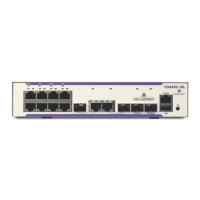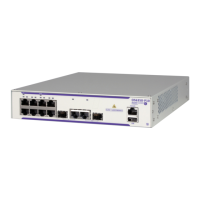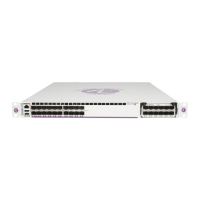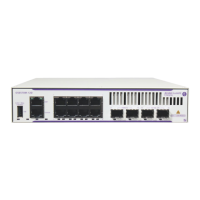Managing OmniSwitch 6450 Stacks Roles Within the Stack
OmniSwitch 6450 Hardware Users Guide September 2015 page 7-13
Pass-Through Mode
The pass-through mode is a state in which a switch has attempted to join a stack but has been denied
primary, secondary, and idle status. When a switch is in the pass-through mode, its Ethernet ports are
brought down (i.e, they cannot pass traffic). Its stacking cable connections remain fully functional and can
pass traffic through to other switches in the stack. In this way, the pass-through mode provides a mecha-
nism to prevent the stack ring from being broken. However, note that when a switch comes up in pass-
through mode, it should not be left unresolved. Pass-through mode is essentially an error state that should
be corrected immediately.
Note. When a switch is in pass-through mode, its information will not display in hardware monitoring
commands such as show chassis, show ni, show module, etc.
Conditions that can trigger a switch to enter pass-through mode include:
• Duplicate slot numbers have been assigned within the stack
• The user has manually forced the switch into pass-through mode using the stack clear slot command
Note. If a switch is forced into pass-through mode, the rest of the stack will not be disrupted. Any
elements in the stack not operating in pass-through mode continue to operate normally.
The most common reason for one or more switches to enter pass-through is duplicate slot number assign-
ments within the stack. So, in order to avoid pass-through mode, it is useful to keep track of the current
saved slot numbers on all elements in the stack. Slot number assignments are stored in the boot.slot.cfg
file in the /flash directory of each switch.
If the stack is booted and the same slot number is discovered on two or more switches, the switch with the
lowest MAC address is allowed to come up and operate normally. Meanwhile, switches with the duplicate
slot number and a higher MAC address come up in pass-through mode. To check the current slot number
stored in each switch’s boot.slot.cfg file, use the show stack topology command. For example:
-> show stack topology
Link A Link A Link B Link B
NI Role State Saved Link A Remote Remote Link B Remote Remote
Slot State NI Port State NI Port
----+-----------+--------+------+-------+-------+-------+-------+-------+-------
1 PRIMARY RUNNING 1 UP 3 StackA UP 2 StackA
2 SECONDARY RUNNING 2 UP 1 StackB UP 3 StackB
3 IDLE RUNNING 2 UP 1 StackA UP 2 StackB
In this example, note that both slots 2 and 3 have a saved slot value of 2. If this stack is rebooted, a dupli-
cate slot error will occur and the switch with the lower MAC address will be given the secondary manage-
ment role. The slot with the higher MAC address will be forced into the pass-through mode.

